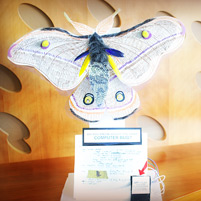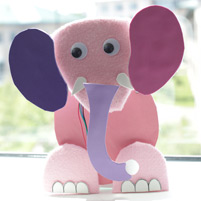From Craft to Bot


Almost anything that can be made with paper, paint and cardboard can be animated — with an educational robotics kit developed at Carnegie Mellon University's Robotics Institute.
No technical experience is necessary to use the kit, but teachers say it fosters interest in technology among students ages 11 and up.
The kit, called Hummingbird, consists of a customized control board along with a variety of lights, sensors and motors that can be connected to the controller without soldering.
Students program their creations with an easy-to-learn, drag-and-drop environment that requires no prior programming experience. The kit is now available for sale ($199) through a CMU spinoff company, BirdBrain Technologies.
While educational robotic kits traditionally have focused on the technology itself — the building of a robot — Hummingbird treats robotics as just one element that can be combined with craft materials and text to communicate thoughts, feelings or ideas.
"We want students to become inventors of technology rather than users of technology," said CMU Robotics Professor Illah Nourbakhsh, whose CREATE Lab developed Hummingbird for a project called Arts & Bots.
"Hummingbird feeds a student's natural curiosity about technology by enabling her to incorporate robotics into something she is making that is meaningful or useful."
The results often amount to kinetic sculptures that use sensors to detect changes in their environment and respond with movement and/or light displays. A cardboard dragon that turns its head and tries to bite anyone who comes close is one example.
"It's not a robot kit where you put all the provided pieces together by following a set of instructions and all the finished robots look and function the same way," said Zee Poerio, a teacher at St. Louise de Marillac Catholic School in Pittsburgh.
Her students used the kit to build a coin "monster" for the school's ancient coin exhibit.
"The Hummingbird provides the students with the ability to make the robots unique not only in design, but in their function."
Terry Richards, who teaches high school human anatomy and physiology at The Ellis School in Pittsburgh, had her students use the kit to build models of the human arm and its musculature.
"They really had to think about where the muscles could attach on their models," Richards said.
In the process, they learned how to install servos to move the elbow and wrist, wire them to the Hummingbird control board and write programs to control the movement.
"Even in high school, students aren't usually introduced to this technology unless they are on the robotics team," she added.
Arts & Bots, originally known as Robot Diaries, was launched with the help of the Heinz Endowments to explore how to foster interest in technology at the middle school level, particularly among girls. "Studies have shown that when they enter middle school, boys and girls are equally interested in robots," Nourbakhsh said.
But three years later, it's very different, with interest down dramatically among girls.
Tom Lauwers, who earned his doctorate in robotics in Nourbakhsh's lab and now heads BirdBrain Technologies, said Hummingbird nicely ties into the increasingly popular "maker movement," the do-it-yourself approach to technology. As with other "makers," students using Hummingbird get hooked on the idea that they can use technology to make all sorts of things, he added.
BirdBrain Technologies and Hummingbird are examples of the kind of innovation that is embedded within the culture of the university and behind CMU's Greenlighting Startups initiative, which is uniquely designed to provide entrepreneurs the keys to success.
![]() Greenlighting Startups is uniquely designed to support CMU's culture of entrepreneurship and new business creation. Learn more »
Greenlighting Startups is uniquely designed to support CMU's culture of entrepreneurship and new business creation. Learn more »
Related Links: Hummingbird Kit | Robotics Institute | Greenlighting Startups
